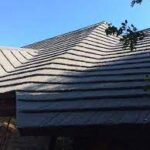Thatched roofs have several advantages, which contribute to their popularity in certain regions and architectural styles. Here are some of the advantages of a thatched roof:
Insulation: Thatched roofs provide excellent insulation, keeping the interior of a building cool in hot weather and warm during colder seasons. The thickness and natural properties of thatch help regulate temperature and reduce the need for additional heating or cooling systems.
Durability: When properly installed and maintained, thatched roofs can be durable and long-lasting. Thatch layers are tightly packed, creating a robust and resilient covering that can withstand various weather conditions, including rain, wind, and even fire.
Sustainability: Thatching is an environmentally friendly roofing option. Thatch materials, typically made from straw, reeds, or grasses, are renewable resources that can be locally sourced. The production process has a low environmental impact compared to other roofing materials, such as asphalt shingles or metal sheets.
Aesthetics: Thatched roofs offer a unique and rustic charm, adding character and a sense of tradition to a building. They are often associated with historical and cultural heritage and can enhance the overall visual appeal of a structure, blending well with natural surroundings.
Sound insulation: Thatch acts as an effective sound insulator, reducing external noise levels. It can dampen sound transmission from rain, hail, or other external disturbances, creating a quieter and more peaceful interior environment.
Ecological benefits: Thatched roofs support biodiversity by providing habitats for insects, birds, and other small creatures. The natural materials and irregular surface of thatch encourage the growth of plants, mosses, and lichens, contributing to the local ecosystem.
Traditional craftsmanship: Thatching is a specialized skill that requires craftsmanship and expertise. Building or repairing a thatched roof often involves skilled thatchers who have mastered the techniques passed down through generations, preserving traditional construction methods and cultural heritage.
It’s worth noting that while thatched roofs have numerous advantages, they also have some considerations and potential drawbacks. These include regular maintenance requirements, the need for experienced thatchers, the risk of fire (although fire-retardant treatments are available), and possible restrictions or regulations in certain areas due to safety or conservation concerns.
We provide thatched roof regulations for owners of thatch lapas, thatch houses, and new thatch roof construction to create new modern thatched roof houses.Thatch roof renovations and thatch roof tiling are done using the FIDDLER™ Thatch tile

